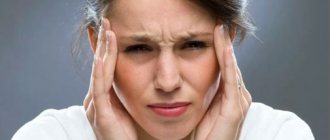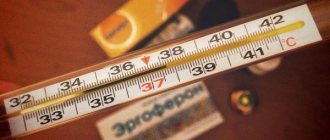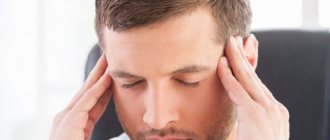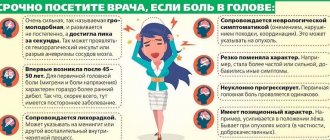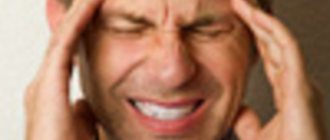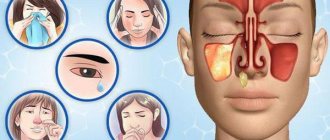“Mom, I have a headache.” Remember how often you heard these words from your child? And, for sure, more than once or twice they thought about the reason for this complaint. However, they did not always find it, believing that it was just a child’s whim or reluctance to go to school. Whereas this symptom often indicates the presence of a serious health problem in the baby.
In addition, sometimes, unfortunately, this happens: the baby is too young to talk about what is bothering him. And then you have only one thing left: to guess the reason for his whims and crying.
Therefore, let's figure out what are the most common causes of headaches in children and how to recognize them, regardless of the age of your baby. And also, what to do and where to go with this problem? Cases of late diagnosis are not uncommon, so the baby receives the wrong treatment. And in this case, one pill simply cannot do it.
What is a headache?
Headache (in medical terminology “cephalalgia”) is any painful sensation in the area from the eyebrows and bridge of the nose to the occipital region.
In fact, a headache is a reflex mechanism that performs a protective function. It consists of receptors that perceive pain stimuli, as well as brain structures that analyze them depending on the source.
Pain receptors are located in all anatomical structures of the head and brain: in the walls of blood vessels, meninges, periosteum, soft tissues of the head and other structures.
It is the irritation of pain receptors by certain substances that gives the sensation of headache. And its appearance is an alarm signal , indicating a change in the normal functioning of the nervous system.
Headaches in children are somewhat less common than in adults. On the one hand, this is evidence that they have an immature nervous system, on the other, it speaks of its high compensatory capabilities.
Neuralgic headache
Neuralgic headaches are rare in childhood. The paroxysmal nature of attacks, the existence of “trigger zones”, the irritation of which provokes an attack, and the irradiation of pain make it possible to distinguish them from headaches of other origins. Neurotic, or psychogenic, headaches in children more often occur at the age of 10 years in the absence of neurological and somatic pathology under the influence of acute or chronic traumatic situations (fear, alcoholism of parents / mother, father /, unbalanced behavior of father and mother, social inability and lack of normal financial security, unfavorable family situation).
Some statistics...
Headache in children is the second most common complaint after abdominal pain.
According to medical statistics, from 3 to 8% of preschool children suffer from headaches, 15% of complaints come from primary school students, but the majority (approximately 80%) come from children over 10 years old.
The peak onset of headaches occurs at age:
- from 6 to 7 years, when it is related to adaptation to school
- 13-15 years old, during puberty
Headache in a child: be careful!
There are about 10 types of headaches, which are a symptom of more than 50 diseases. However, we will consider the most common of them, analyze the mechanisms of their occurrence, as well as the main manifestations.
Migraine
Occurs in 20-23% of children.
And oddly enough, often this disease first makes itself felt in childhood. Moreover, its symptoms are somewhat different from the type of migraine in adults. Therefore, diagnosis is often difficult even for fairly experienced doctors.
The causes and theories of migraine are still unknown. There are assumptions on this matter that are only speculative.
The most common theory of origin
The relationship between the trigeminal nerve and the blood vessels of the brain is disrupted. As a result, substances are released that reduce vascular tone, leading to swelling of the tissues around them, which irritates pain receptors. In addition, it has been proven that there is a hereditary predisposition to migraine. It is noteworthy that girls get it somewhat more often.
Symptoms
Unlike migraine in adults , children's has its own characteristics:
- The attack is short : it can last from 30 minutes to 5 hours.
- Throbbing pain is often bilateral in nature (whereas in typical cases in adults it is unilateral), localized in the parietal, frontal or occipital region.
- Often a headache attack is accompanied by dizziness, fainting or lethargy - the so-called basilar migraine.
- Almost every attack occurs with abdominal pain , nausea and vomiting.
- At the beginning of the attack, the headache is not expressed. Therefore, if the baby is passionate about playing, he may not immediately draw your attention to the deterioration of his well-being. And when the pain becomes unbearable, your child may be taken to the hospital by ambulance with an erroneous diagnosis (for example, meningitis).
- And at the same time, often the only sign of childhood migraine is abdominal pain and nausea, without headache (“headless migraine”).
- The onset of an attack is sometimes preceded by an aura : the baby’s mood may change sharply, auditory and visual (dark spots, zigzag lines) hallucinations and other symptoms may appear.
A migraine attack is often provoked by:
- stressful situations
- sleep-wake disturbances
- consumption of certain products: cocoa, chocolate, citrus fruits, products containing preservatives
- strong odors or bright lights
- excessive exposure to a monitor or TV screen
- in teenage girls, changes in the menstrual cycle and some other factors
Tension headaches
Occurs in 70-75% of cases.
Most common reasons:
- physical and mental stress
- violations of the organization of the daily routine
- uncomfortable position while sleeping
- stressful situations (after intense lessons or passing exams, the child’s worries about family troubles or relationships between peers, and so on)
- staying in a stuffy room for a long time or sitting in front of a computer monitor (as a result, the muscles of the neck and shoulder girdle become tense)
- changes in weather conditions (wind, rain, sudden changes in atmospheric pressure)
- forced fasting
However, unfortunately, sometimes the reason remains unclear.
Mechanism of occurrence
It is not completely clear. But most researchers believe that the underlying cause is muscle tension in the head muscles , which can occur in two cases.
- Local mechanism
Due to stress or awkward posture, the muscles of the head, scalp, neck and shoulders become tense. As a result, a nonspecific inflammatory reaction occurs. It causes the blood vessels to dilate and release specific substances into the blood that irritate pain receptors.
- Central mechanism
The ability of some brain structures (limbic-reticular formation), which ensure the performance of the most important functions of the body, to adequately respond to external influences changes.
This leads to disruption of emotional activity and the functioning of the autonomic nervous system (regulates the tone of blood vessels and muscles, the production of hormones, and the functioning of some internal organs). As a result, anxiety increases, which in turn is accompanied by an increase in muscle tone of the scalp, head and neck, and sometimes disruption of the functioning of some internal organs.
Symptoms
The baby most often complains of a headache in the forehead and temples, somewhat less often in the crown area. It is monotonous and moderate in strength, has a pressing, squeezing or constricting nature, like a “helmet” or “helmet” (the baby uses his palm to show the place of pain). Most often occurs in the afternoon.
The headache may last from one to several hours. Sometimes it goes away on its own after a little sleep or rest, or a change of activity. As the baby grows, the frequency and duration of attacks increases, but the nature of the pain itself does not change.
It is noteworthy that the child does not like to comb his hair or refuses to wear hats, even light ones. Because these effects on overstrained muscles worsen the headache.
Often, along with a tension headache, pain appears in the joints, muscles, abdomen, and in the heart area. Such complaints may be accompanied by labile mood, asthenia (increased fatigue and exhaustion), causeless anxiety, poor appetite, and sleep disorders. This is due to disruption of the autonomic nervous system.
Headache with changes in intracranial pressure
Normally, intracranial pressure is maintained by three components: the volume of the brain, cerebrospinal fluid (circulates in the cranial cavity and the spinal cord space), as well as the blood supply to the vessels of the brain. Therefore, the brain seems to be in a suspended state, held in place by the vessels and nerves of the brain like “anchors.”
An increase in the volume of one of these components leads to an increase in intracranial pressure (intracranial hypertension), while a decrease leads to a decrease in it (intracranial hypotension).
Intracranial hypertension
It develops most often in children.
Mechanism of occurrence
The production of cerebrospinal fluid increases, but its absorption is impaired or there are obstacles to its free circulation. As a result, the volume of cerebrospinal fluid increases and puts pressure on pain receptors.
Causes
- consequences of traumatic brain injuries, even very long-term ones (for example, postpartum)
- hydrocephalus (excessive increase in the volume of cerebrospinal fluid in the cranial cavity)
- intrauterine oxygen deprivation (hypoxia)
- bacterial or viral infections (for example, meningitis or encephalitis, ARVI)
- brain tumors
- congenital malformations of the brain.
Symptoms
The child complains about:
- bursting headaches (most often in the afternoon), which feel like they are deep in the head
- heaviness in the head in the morning
- increased sweating
- nausea or vomiting that gets worse with vigorous movement
- fatigue
- worsening headache when coughing, sneezing, or straining.
Often the baby refuses to play, is whiny, irritable, and sleepy.
Intracranial hypotension is rare : mainly in adult patients.
Headaches due to ENT diseases (tonsillitis, inflammation of the paranasal sinuses, adenoid growths)
Not a rare occurrence.
They are caused by a toxic effect on the vessels of the brain and irritation of the meninges by pathogenic microorganisms, their decay products, and high temperature. This leads to increased intracranial pressure, which manifests itself in fairly intense headaches. All other symptoms associated with these diseases are described above (intracranial hypertension).
Headaches due to neuroinfections
They are always accompanied by diseases such as acute respiratory viral infections, meningitis, and encephalitis.
They arise due to increased intracranial pressure, the symptoms of which are described above. The headache is severe and worsens when lying down.
However, in this case the body temperature rises. Vomiting, nausea, and severe weakness may occur. Sometimes the child loses consciousness or develops convulsions (in severe cases). In addition to this, symptoms of the underlying disease are observed.
Headache due to visual impairment
Recently, this has been happening more and more often, since a colossal burden is placed on a fragile child’s body at school and kindergarten. It develops with both farsightedness and myopia, and sometimes with other visual impairments when there is weakness of the eye muscles.
Mechanism of occurrence
Due to overstrain of the eye muscles, the nerve endings of the trigeminal nerve are irritated, which causes headaches.
Symptoms
The pain is aching and dull. Most often it starts from the bridge of the nose. However, it often starts from the forehead or back of the head, gradually spreading throughout the entire head, often even moving to the neck.
A headache appears after prolonged overstrain of the eye muscles: reading a book, watching TV, standing in front of a monitor screen, and so on. It does not go away after taking medications. The only way out is the right glasses.
Sarklinik knows how to cure headaches
Comprehensive differentiated treatment of patients (children and adults - men and women) with headaches in Saratov with the widespread use of new reflexology methods allows us to achieve satisfactory results even with severe symptoms. At the first consultation, the doctor will tell you what remedies there are for headaches, what to do if your forehead hurts, severe headaches in the back of the head, in the forehead, in the temples (temporal), in the eyes, ear, after tension, no pills or remedies help , drugs? Do you or your child constantly suffer from weakness, dizziness, headaches? Go to the doctor. Cephalgia is successfully treated.
Sign up for a consultation. There are contraindications. Specialist consultation is required. Photo: Justmeyo | Dreamstime.com\Dreamstock.ru. The people depicted in the photo are models, do not suffer from the diseases described and/or all similarities are excluded.
Related posts:
Dyslalia in children, characteristics, forms, correction, treatment
Agrammatism, paragrammatism, dysgrammatism
Tics, nervous tics, treatment, hyperkinesis, hyperkinesis treatment
Bruxism, teeth grinding during sleep, odonterism: symptoms and treatment
Yactation, rocking, nodding movements of the head, torso, body
Comments ()
The baby can’t speak: how can you tell if he has a headache?
It's probably not easy. Especially in the first months of a child’s life and until he is one year old. However, if you “listen” a little to your baby, he himself will “tell” you about what is bothering him.
You should be wary:
- frequent regurgitation or vomiting not associated with food intake (usually in the morning)
- unreasonable restlessness or crying out
- the appearance of a cry on one note in the baby , lasting for several hours
- shaking of the baby's arms and legs (tremor)
- increased pain sensitivity (sometimes even just touching the skin causes a painful cry in the baby)
- presence of ocular signs: strabismus, Greffe's sign (when the eye is lowered down, a white stripe remains between the iris and the upper eyelid)
- bulging and pulsation of the large fontanel (normally it is level with the bones of the skull or sinks somewhat) - observed with increased intracranial pressure
- an increase in the size of the head circumference (most often with hydrocephalus), so it should always be measured and ensure that it corresponds to age standards
- poor sleep : the baby often wakes up or cannot sleep.
Even if a child can already speak, he cannot always provide accurate information about his well-being. As a rule, this is up to 4-5 years of age. Therefore, pay attention to how the baby behaves. If he has a headache, he often puts his hands to his head, eyes or eyebrows, and ruffles his hair.
